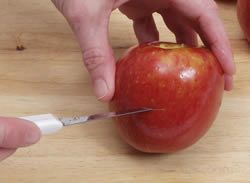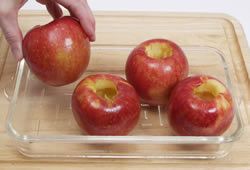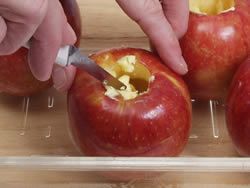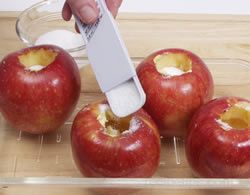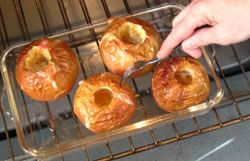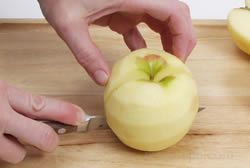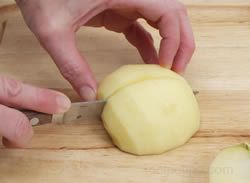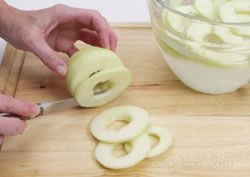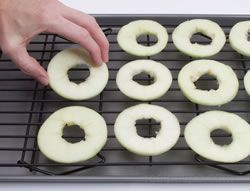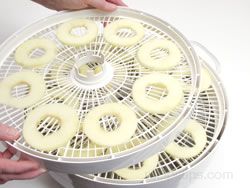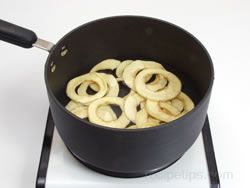 |
Apple Cooking - Cooking Tips | |||||||||||||||||||||||||||||||||||||||||||||||||||||||||||||||||||||||||
| view article online: https://www.recipetips.com/kitchen-tips/t--1303/apple-cooking.asp | |||||||||||||||||||||||||||||||||||||||||||||||||||||||||||||||||||||||||
| |||||||||||||||||||||||||||||||||||||||||||||||||||||||||||||||||||||||||
|
Peel four cooking apples (see Types of Apples - Choosing the Best Apple for selection of cooking apples). Cut apples in half and then into quarters. |
|
|
Remove the cores from each of the quarter sections. See Apple Preparation for more information on coring apples. |
 |
|
Cut quartered sections into slices 3/8 to 1/2 inch thick. Place slices in water with lemon juice to prevent browning. Do not over soak slices. See Preventing Apples from Turning Brown for more information of preventing browning. |
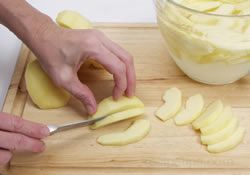 |
| Drain the apples and pat dry with paper towels before adding to the skillet. | 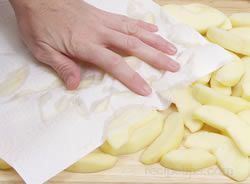 |
| Melt 2 tbsp. of butter or margarine in a large skillet until bubbling. Add apple slices. | 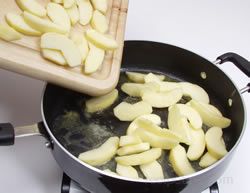 |
| Cook apples over medium high heat for approximately 5 minutes or until tender crisp and beginning to brown. Turn several times to brown evenly. | 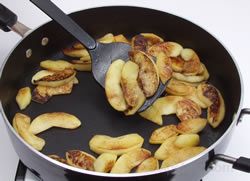 |
| Add 4 tbsp. of brown sugar and continue to cook until sugar has melted and started to caramelize. Apple slices should be tender. | 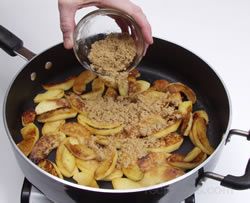 |
| Serve as a side dish while still warm. | 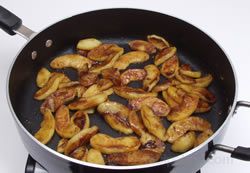 |
Cooking Applesauce
Applesauce is a popular food that is simple to cook and made with few ingredients. The basic ingredients consist of cooking apples, sugar and water. Other ingredients, such as cinnamon, nutmeg, cloves, lemon juice or zest, and apple cider, can be added to enhance the flavor. The recipe below is for a simple applesauce, using basic ingredients.
|
Peel five to six medium cooking apples (see Types of Apples - Choosing the Best Apple for selection of cooking apples). Cut apples in half and then into quarters. |
|
| Remove the core from the quartered sections. |  |
|
Cut quartered apples into thick slices. See Apple Preparation for more information on slicing apples. Place slices immediately in water with lemon juice to prevent browning. Do not allow apples to soak for more than 15 minutes. |
 |
| Add 1/2 cup of cold water to a heavy 2-quart saucepan. Drain slices and add them to the saucepan. | 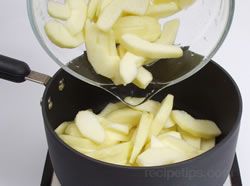 |
| Bring apples and water to a boil over medium heat. Cover apples and reduce heat to low. For chunky sauce simmer apples for 8 to 10 minutes. For smoother applesauce, simmer for 12 to 15 minutes. | 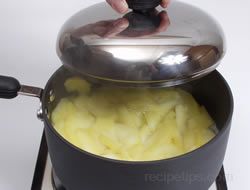 |
| Add 1/2 cup of sugar during the last 2 or 3 minutes of cooking time. |
|
| Stir sugar into the sauce and finish cooking to desired consistency. | 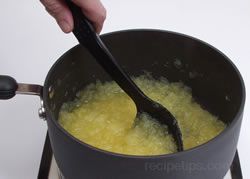 |
| The applesauce can be served warm or chilled. Before storing in the refrigerator, allow the applesauce to cool and then place in a sealed container. |  |
Drying Apples
Drying apples removes the moisture from the apple, leaving it with a concentrated flavor. Dried apples make a sweet nutritious snack and are easy to store. They can also be reconstituted (see below) for use in sweet and savory dishes. There are several methods that can be used to dry apples. They can be sun dried, oven dried, or dried in a dehydrator. The different methods are explained below.
Preparation:Rings - Peel apples and leave whole. Remove the core and slice apples into 1/8 thick rings. See Apple preparation for information on coring the center of the apple. Slices - Peel apples and cut into quarters. Remove the core and cut sections into 1/8 inch thick slices. |
|
| Place slices immediately in water with lemon juice to prevent browning. Allow the slices to soak for a few minutes and drain. Pat the slices dry with paper towels. |  |
Sun Drying:Place prepared slices or rings in a single layer on a wire rack placed on a baking sheet. Do not allow apple sections to be touching. Cover with cheesecloth and place in the sun in a well ventilated area. Turn slices every couple of hours. Bring apples in at night. The drying process will take 2 to 3 days. This is not the preferred method for drying since it is slow and the drying process is hard to control. | |
Oven Drying:Place prepared slices or rings in a single layer on a wire rack placed on a baking sheet. Do not allow apple sections to be touching. |
|
| Place, uncovered, in an oven preheated between 125° to 150° F. Dry for 6 to 8 hours, turning after four hours and checking for dryness after six hours. If not dry, check again after two more hours. | 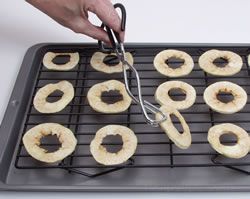 |
| Apples are dried sufficiently when no moisture remains in the middle of slice when it is torn open. The dried apples will be pliable with a leathery texture. |  |
Drying in Dehydrator:Using a dehydrator is the most consistent method for drying. Prepare in same manner as above. Place slices or rings on the trays of the dehydrator, being careful that the apples do not touch. This allows more even air movement during drying time. |
|
| See the dehydrator manufacturer's manual for suggested drying time. Turn slices or rings over about half way through the drying time and rotate dehydrator trays. |  |
| After the apples have dried sufficiently, allow them to cool completely and then store in sealable plastic bags or covered plastic or glass containers. Store in the refrigerator or in a dark area where it is cool and dry. | |
Reconstituting Dried Apples | |
|
Method 1:
|
|
| Bring liquid to a boil, cover, and reduce heat to a simmer. Allow to simmer for approximately 30 minutes or until apples are at the desired tenderness. | 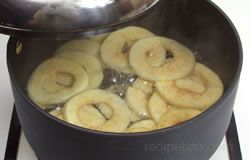 |
| Drain and prepare as desired. | 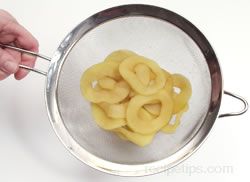 |
|
Method 2:
| |
All About Apples - Additional Articles:
Types of Apples | Apple Preparation | Prevent Browning
